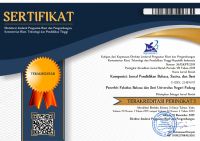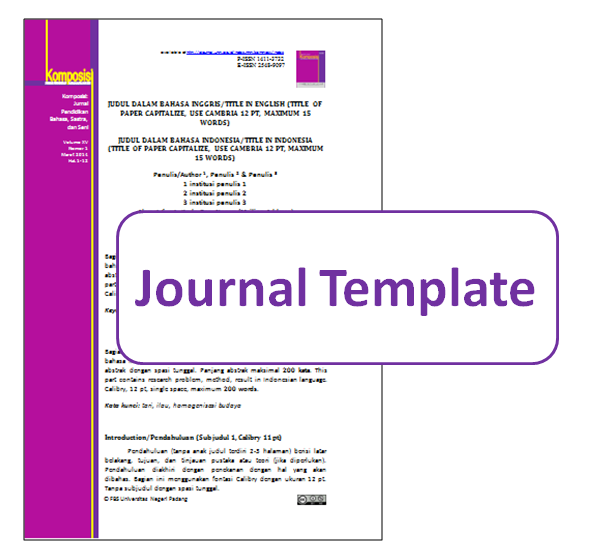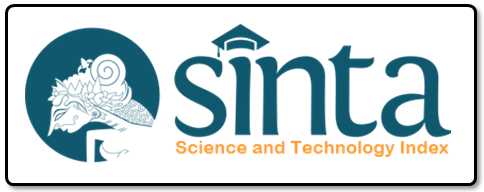Learning Process Experiment through Peer Tutoring in the Typography Subject from Students Learning Motivation of Arts Department FBS UNP
Yusron Wikarya, Syafei Syafei, Yofita Sandra, Ernis Ernis
Abstract
The goal of this study is to see how peer tutoring strategies and student learning motivation affect Typography learning outcomes at Fine Art Department Faculty of Languages and Arts Universitas Negeri Padang (FBS UNP), as well as how they interact with one another. A quasi-experimental design with a 2X2 factorial design was used in this study. To collect research data, a learning motivation questionnaire and learning outcomes tests were used. After that, the data was analyzed using the Analysis of Variance Test (ANOVA). The research findings show that: 1) students who are taught using peer tutoring strategies have different or higher typography learning outcomes than students who are taught conventionally or without using peer tutoring strategies, 2) High learning motivation students have different or higher typography learning outcomes than low learning motivation students. According to the study's findings, peer tutoring strategies and learning motivation improve student learning outcomes in Typography courses. In terms of influencing student learning outcomes, they are not mutually dependent. As a result, peer tutoring strategies are extremely effective, and lecturers must continuously improve learning motivation throughout the learning process in order to improve student learning outcomes, particularly in the Typography subject.
Keywords
peer tutoring, typography, learning motivation
References
Arikunto, S. (2002). Prosedur Penelitian Suatu Pendekatan Praktek. Rineka Cipta.
Djamarah, S. B. (2002). Psikologi Belajar. Rineka Cipta.
Irianto, A. (2004). Statistik Konsep dasar dan Aplikasinya. Prenada Media.
Prayitno, E. (1989). Motivasi Dalam Belajar. P2LPTK Ditjen Pendidikan Tinggi Depdikbud.
Riduwan. (2006). Belajar Mudah Penelitian Untuk Guru, Karyawan, dan Peneliti Muda. Alfabeta.
Sardiman. (2008). Interaksi dan Motivai Belajar Mengajar. PT. Raja Grafindo Persada.
Semiawan, C. dkk. (1987). Pendekatan Keterampilan Proses Bagaimana Mengaktifkan Siswa Belajar. Gramedia.
Setiawati, L. (2008). Analisis Diagnostik Kesulitan Belajar Matematika Melalui Bantuan Tutor Sebaya.
Sudjana, N. (2004). Dasar-Dasar Proses Belajar Mengajar. Sinar Baru.
Suhadi. (2008). Motivasi Belajar-Gunakan Mahasiswa Pandai Menjadi Tutor Sebaya Bagi Temannya.
Suryabrata, S. (2000). Psikologi Pendidikan. PT. Raja Grafindo Persada.
Suwanda. (2007). Pengelolaan Pembelajaran Tutor Sebaya. online.
Suyanto. (2006). Pengaruh Bantuan Tutor Sebaya Dalam Pembelajaran Kooperatif Tipe TGT terhadap Prestasi Belajar Mahasiswa SMP.
Syahroni, F. (2014). . Persepsi Siswa Terhadap Manfaat Pelaksanaan Praktek Kerja Industri Di SMKN 1 Lembah Gumanti. Jurnal Bahana Manajemen Pendidikan. Administrasi Pendidikan, 2(1), 275 ‐ 831.
Wikarya, Y. (2018). Tipografi & Kaligrafi,. Pendidikan Seni Rupa FBS Universitas Negeri Padang.
DOI:
https://doi.org/10.24036/komposisi.v23i2.119040
Refbacks
There are currently no refbacks.
Copyright (c) 2023 Komposisi: Jurnal Pendidikan Bahasa, Sastra, dan Seni
This work is licensed under a
Creative Commons Attribution-NonCommercial 4.0 International License .
Komposisi: Jurnal Pendidikan Bahasa, Sastra, dan Seni , a peer-reviewed online journal in languages, literature, and arts education.
Printed ISSN 1411-3732 , Online ISSN 2548-9097 .
Currently, Komposisi: Jurnal Pendidikan Bahasa, Sastra, dan Seni is indexed by: View My Stats
Visitors since February 2017:
Statcounter <div class="statcounter"><a title="web analytics" href="http://statcounter.com/" target="_blank"><img class="statcounter" src="//c.statcounter.com/11239717/0/d5796c6b/0/" alt="web analytics"></a></div> View My Stats
Published by:
Universitas Negeri Padang (UNP) Address: Faculty of Languages and Arts (FBS) Universitas Negeri Padang. Jl Prof. Dr. Hamka Air Tawar Barat, Padang - West Sumatera -Indonesia Telp/Fax. +62751 7053363 Home page: http://ejournal.unp.ac.id/index.php/komposisi | e-mail:komposisi.fbsunp @ fbs.unp.ac.id | cc: havid_a @ fbs.unp.ac.id
Server Luar
slot88
King Wood Car Care slot gacor
scam
situs toto
bandar togel
bandar togel
Slot Gacor Hari ini
situs toto
situs toto
toto togel
togel online
topup murah
harapan777
AMDBET
toto togel
slot88
login bayar4d
macau303
slot resmi apk slot online Slot Maxwin
situs toto
sakti55
situs toto felix168
nextogel
NEXTOGEL
NEXTOGEL
NEXTOGEL
NEXTOGEL
NEXTOGEL
NEXTOGEL
NEXTOGEL
NEXTOGEL
NEXTOGEL
NEXTOGEL
NEXTOGEL
NEXTOGEL
NEXTOGEL
NEXTOGEL
NEXTOGEL
NEXTOGEL
NEXTOGEL
NEXTOGEL
NEXTOGEL
NEXTOGEL
NEXTOGEL
NEXTOGEL
NEXTOGEL
NEXTOGEL
NEXTOGEL
NEXTOGEL
NEXTOGEL
NEXTOGEL
NEXTOGEL
NEXTOGEL
NEXTOGEL
JEPETOGEL
JEPETOGEL
JEPETOGEL
JEPETOGEL
KIM369
KIM369
KIM369
KIM369
KIM369
KIM369
KIM369
KIM369
KIM369
KIM369
situs toto toto slot kuntogel
situs toto toto slot sendok88
togel online toto slot https://www.eaglehighplantations.id/
toto macau
slot gacor slot gacor
batak5d toto slot Slot88 www.onscripture.com
slot online
situs toto
situs gacor bandar togel resmi toto togel https://montreallawfirm.com
wild west gold sering pecah
Toto 4D
slot88
toto macau
Situs Toto
Situs Toto
https://mercubuana.org/
Toto 4d
toto 4d
Toto 4D
toto 4d
info rtp akurat malam ini
Wanita Subang Beli mobil dari Nolimit city
rahasia Cuan Aztech Gems
Gatot kaca Buat TKW Jadi jutawan
Rahasia sukses bermain Mahjing wins
harapan princess starlight
Harapan sweet bonanza
taktik gates of olympus xmas
dukungan gates olympus
rahasia sukses bermain mahjong ways
Situs togel
slot gacor 2025
luxury89
Sulebet
sulebet
oja89
basic4d
situs toto togel online
vipbet888
momo128 login
https://garudafood.org/
jpmania mesin128
mesin128
mesin128
oja89
slot gacor
jumat4d slot login
https://pintu-pro.id/
slot gacor
Buat yang suka cari link slot gacor hoki69 maxwin tiap hari, ini tempat yang paling sering gue datengin.
choicehomecontractors.com
sarangslot
slot 4d gacor hari ini
Toto 4D
https://up2m.pkr.ac.id/jepangbet/
slot
simpatitogel
slot gacor hari ini
slot gacor
slot
https://unesa.id/












